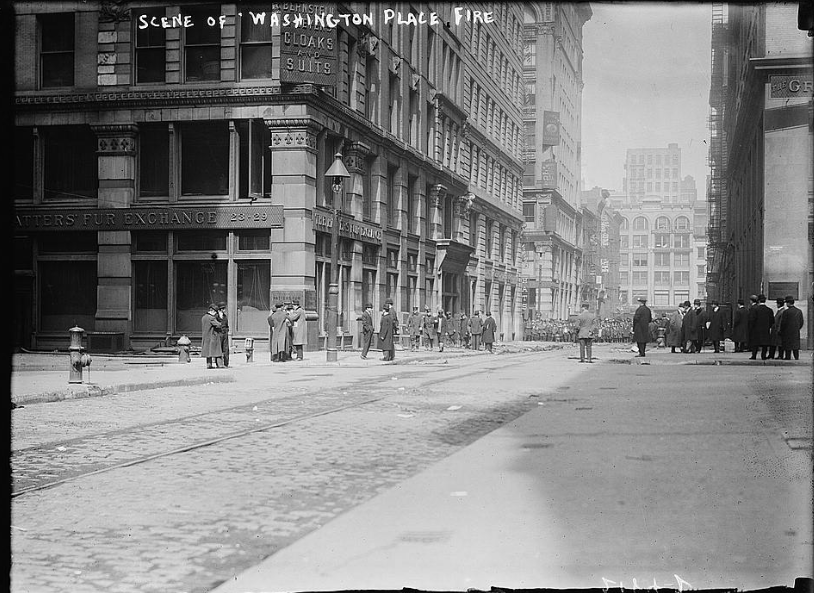
Also known as the Washington Place Fire, the Triangle Shirtwaist Factory Fire claimed the lives of 146 workers.
It was Saturday March 25, 1911. At 4:45 pm, a man walking by the 10-story Asch building saw smoke coming out of the 8th floor window and signaled the fire station.
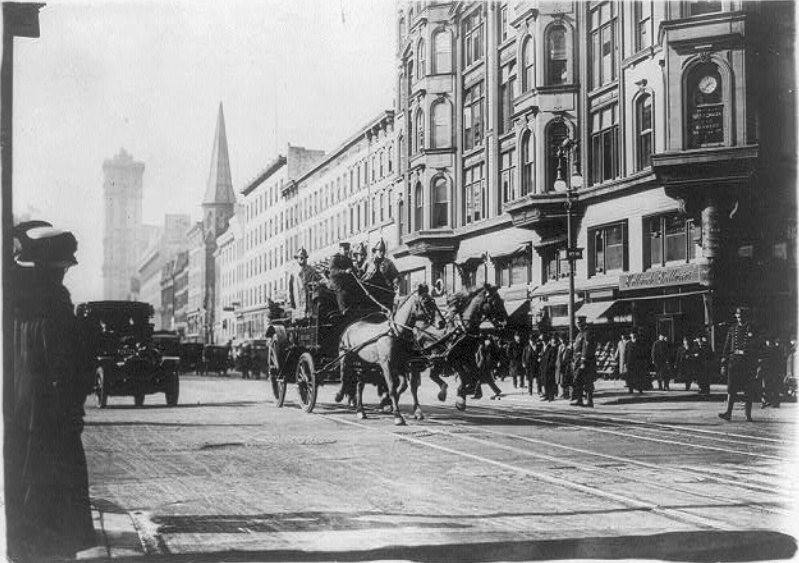
Inside the building, a bookkeeper on the 8th floor noticed the smoke and called up to the tenth floor to warn them about a fire. There was no way to contact the people on the 9th floor.
The workers, mostly young women, had been busy at their sewing machines, making women’s blouses, called shirtwaists.
When the call of fire was shouted out, people naturally panicked. They ran to the exit doors but could not escape because the exits were locked to prevent the workers from taking unauthorized breaks.
Some people managed to escape the flames by taking the stairway up to the roof, but it only took three minutes for the stairway to become engulfed in flames and completely inaccessible.
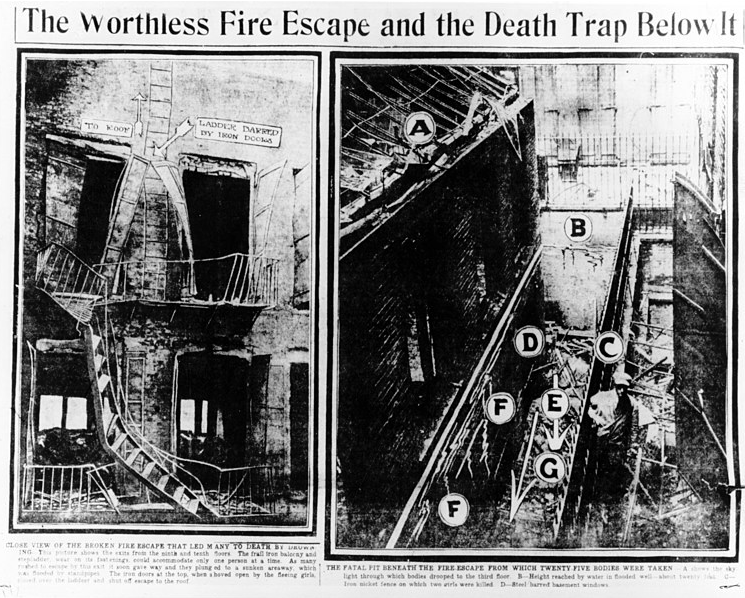
The doors leading to the stairway also opened inward and Fire Chief Croker reported that he had found dozens of charred bodies piled against the doors on the ninth floor.
A few terrified people managed to jam themselves into the elevator while it was still working, but it soon became too hot for the elevator to work.
With no place left to run, people jumped from the high windows marked with Xs on this photo.
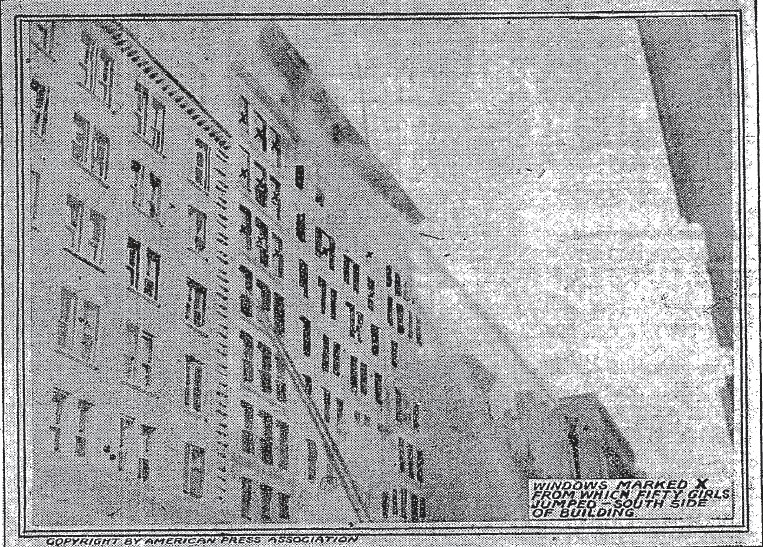
Reporter William Gunn Shepard wrote, “I learned a new sound that day, a sound more horrible than description can picture – the thud of a speeding living body on a stone sidewalk.”
“They were burning to death in the windows. One by one the window jams broke. Down came the bodies in a shower, burning, smoking, flaming bodies, with disheveled hair trailing upward. These torches, suffering ones, fell inertly. The floods of water from the firemen’s hoses that ran into the gutter were actually red with blood.”
One young woman survived the fall. It was reported that:
“Ida Singer, a 17-year-old shirtwaist maker who lies in her home suffering from a few minor bruises and cuts, has perhaps the strangest story to tell of any of the hundreds who escaped death in the Washington Place fire horror. She was found by the firemen hanging half conscious to a spike in the rear wall of the building opposite the third floor landing. She had fallen from the fire escape at the ninth floor, but the pointed spike caught in her clothing and saved her life.”
https://chroniclingamerica.loc.gov/lccn/sn85025570/1911-03-28/ed-1/seq-4/
She later told newspapers that:
“When I first heard the alarm I was too frightened to run. I crept to the rear to a window opening on the narrow fire escape. Flames were roaring out of the windows below. I knew I had to go down the narrow escape and climbed out. As I did so I looked back and I saw many girls at the window I had just left. I felt that I had to get down ahead of them. The iron ladder was hot and was getting hotter as I went down. I had taken probably three steps downward when the first of the girls rolled out of the window above me, crashing down on me and I lost my balance and felt myself falling. I remember I was almost glad of it before I lost my senses.
“When I woke up I was in the funniest position. I had to stop and study it out. My hands were down by my feet and i was doubled up. I heard men and women far off shouting and screaming. I tried to move and couldn’t. After a long time I heard a voice and a window was opened. Two men got hold of me and took me into the building. My coat, my skirt, and my hat remained on the spike on the side of the wall. The men wanted to know how I caught on that spike and I told them I fell from the ninth floor. In spite of the horror of the situation we all laughed as we thought of it. But I shall never forget what I saw as I hung on that spike. Men and women were piled upon each other. Many were quite still but others were shouting and were waving their hands frantically.”
https://chroniclingamerica.loc.gov/lccn/sn85049554/1911-03-27/ed-1/seq-1/

New York Police Captain Dominick Henry said:
“Dozens of girls were hanging from the ledges. Others, their dresses on fire, were leaping from the windows.”
About 20 people crowded onto an exterior fire escape, but with the weight and the heat from the fire, it collapsed, dropping the people to their deaths on the concrete pavement below.
Others simply succumbed to the smoke and flames within the building.
The fire department did their best trying to reach the flames, but their ladders only reached to the 7th floor and bodies were falling to the ground around them.
Inside, some of the victims pried open the elevator doors and either jumped down the shaft or attempted to slide down the cables.
Celia Walker was one of the people who survived going down the elevator shaft. According to her story, she was an examiner on the ninth floor and was at her table when she heard girls screaming.
“She ran toward the Greene street side and saw a big crowd at the door. She said she climbed on the machine tables and got to the… elevator. She waited there for a while and then ran to the door and tried to open it, but could not. She then ran back for the elevator and although it came up, she could not get on. However, the elevator door was not closed, and she held on to the door so that it could not be closed.”
“I was being pushed,” she said, “and I jumped into the well and caught the cable. I slid down and remember seeing the mob on the fifth floor, and then I don’t remember what happened. I was unconscious after that.”
https://chroniclingamerica.loc.gov/lccn/sn83030193/1911-12-12/ed-1/seq-4/
Fire Marshal Beers investigated the events that led to so many deaths, and said:
“Edward Brown and other machinists tried to get the girls in line to march them to the elevators and stairways. The poor things did not know what was meant, as most of them did not understand English.
“Terrible confusion resulted, and a perfect babel of tongues swelled higher and higher as the flames spread. The girls were seated at the sewing machines so closely that their backs touched. Stools blocked their way to safety, and the first fleeing victims, stumbling over the stools, were thrown into a struggling, screaming mass and remained in this condition while the moments which meant life or death went by.
“There were only 15,000 square feet of floor space for the girls, their machines and the cutting tables. If all of them had marched quietly to the little fire escape it would have taken three hours to get them down… The building was endorsed as safe by the state labor department.”
https://chroniclingamerica.loc.gov/lccn/sn99063957/1911-03-27/ed-1/seq-1/
People crowded around below and watched as 62 victims dropped to their death from the burning building.
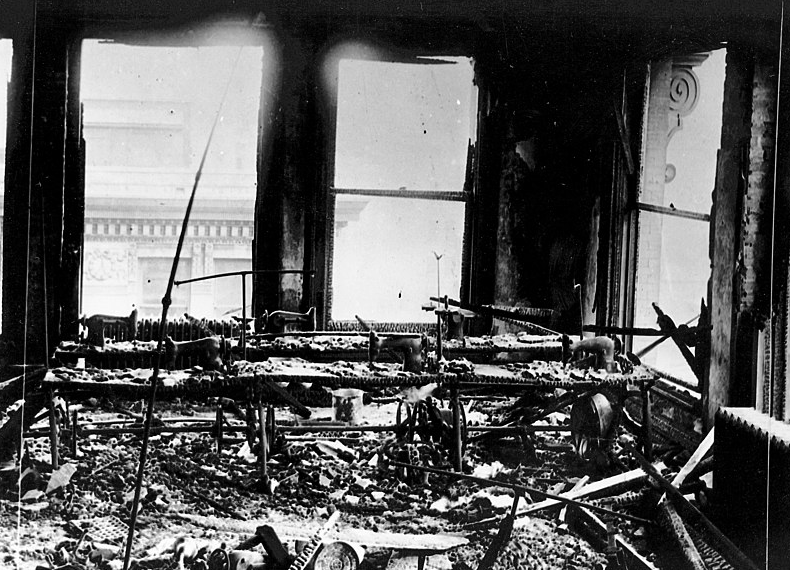
Louis Waldman, a witness to the event, wrote:
“Word had spread through the East Side, by some magic of terror, that the plant of the Triangle Waist Company was on fire and that several hundred workers were trapped. Horrified and helpless, the crowds—I among them—looked up at the burning building, saw girl after girl appear at the reddened windows, pause for a terrified moment, and then leap to the pavement below, to land as mangled, bloody pulp. This went on for what seemed a ghastly eternity. Occasionally a girl who had hesitated too long was licked by pursuing flames and, screaming with clothing and hair ablaze, plunged like a living torch to the street. Life nets held by the firemen were torn by the impact of the falling bodies.
“The emotions of the crowd were indescribable. Women were hysterical, scores fainted; men wept as they hurled themselves against the police lines.”
The next day, hundreds of people lined up outside the makeshift morgue to claim their family members.
And then they mourned.
The owners of the company survived the fire and were brought to trial, but nothing came of it. In 1913, a civil suit was brought against them and the families of the deceased were each awarded a mere $75 per victim that was paid for by the company’s insurance.

